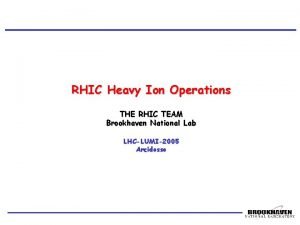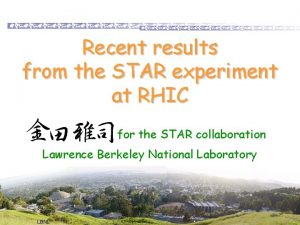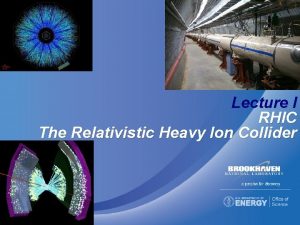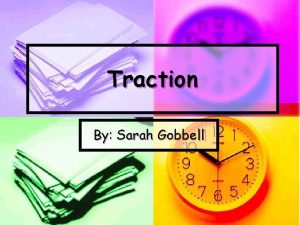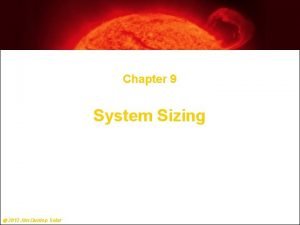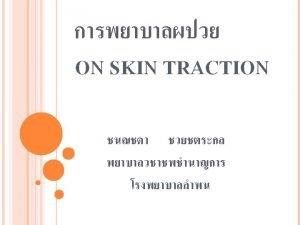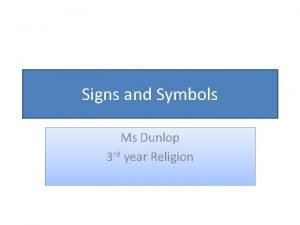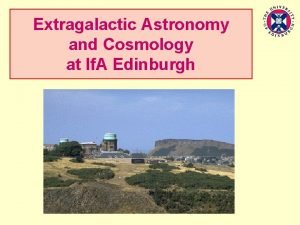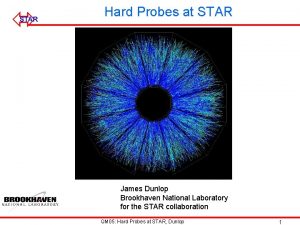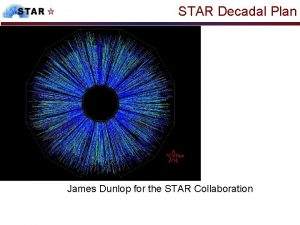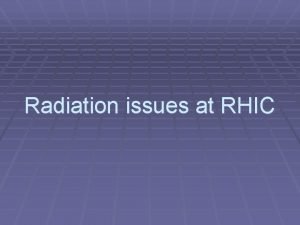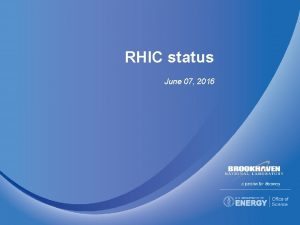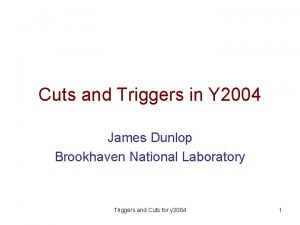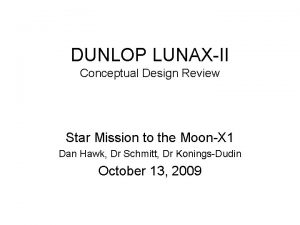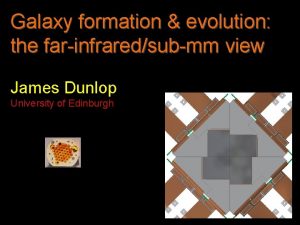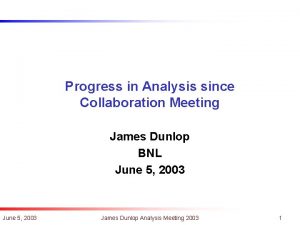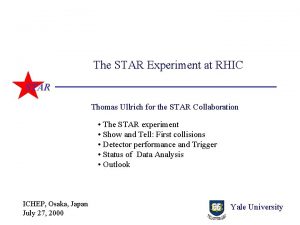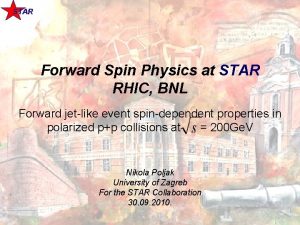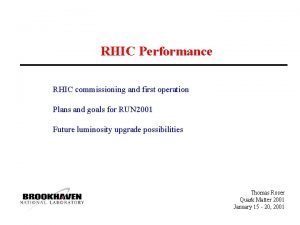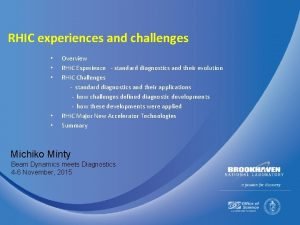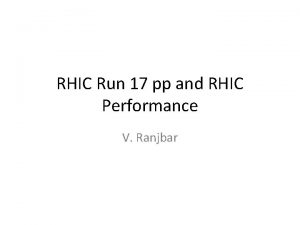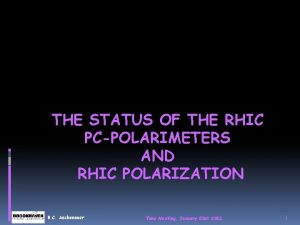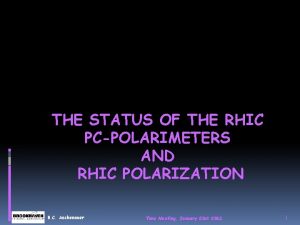STAR and me RHIC James Dunlop 1 STAR
















- Slides: 16

STAR and me. RHIC James Dunlop 1

STAR: A Correlation Machine Tracking: TPC Particle ID: TOF Electromagnetic Calorimetry: BEMC+EEMC+FMS (-1 ≤ ≤ 4) Upgrades: Muon Tracking Detector HLT Heavy Flavor Tracker (2013) Full azimuthal particle identification over a broad range in pseudorapidity Forward Gem Tracker (2011) 2

Asymmetric Coverage • STAR asymmetric: forward detectors face the Blue Beam – η < -1 (facing the Yellow Beam): Empty of detectors • Services for the HFT (2014) with lots of material OR • New instrumentation with a major rework of the HFT (or no HFT) – TOF+BEMC+TPC: -1 < η < 1 • Excellent PID, electron id, proven jet finding to 50 Ge. V – EEMC + FGT: 1 < η < 2 (facing the Blue Beam) • Proven EM Calorimetry, new tracking (FGT) optimized for high-E electrons • Capabilities for electrons of ~few Ge. V and hadronic portion of jets need investigation and likely upgrades – FMS: 2. 5 < η < 4 (facing the Blue Beam) • Proven EM calorimetry • No tracking at all. Upgrade needed, may need new magnet – Upstream (symmetric) Roman pots: upgrade ready by ~mid-decade – ZDC’s existing and proven on both sides 3

Kinematics at 4+100 Scattered electron Scattered jet 4+100 open kinematics: scatters the electron and jet to mid-rapidity Forward region (FMS): Electron either Q 2 < 1 Ge. V, or very high x and Q 2 Jet either very soft or very hard Note: current thinking has hadron in the blue beam: optimized for high x and Q 2 4

me. RHIC and saturation Only can begin saturation search in Endcap, if hadrons in the yellow beam 5

Energy loss in Cold Nuclear Matter • Reasonable reach in jet energy (20 -50 Ge. V), especially in the choice where the hadron is in the blue beam • Cross-section ~1/(x Q 4); rate should be Ok 6

10+100, Saturation reach • At higher EIC energies, electron should go towards the forward detector to enable reach into saturation region: FMS region 7

Speculative: 30+130 • Forward region very important for higher energy options 8

Spin: History and (some) Open Questions 1989 - European Muon Collaboration measured g 1(x, Q 2) down to x ~ 10 -2, and concluded: “Quark spins contribute only about 20 -30% of the proton spin, and strange quarks are negatively polarized, ” The former relies on extrapolation to x ~ 0, - How? The latter has not been confirmed in semi-inclusive DIS (with Kaons), - Why? What is the role of gluon spins? - RHIC has started to answer this, for ~0. 03 < x < ~0. 3, thus leaving huge voids to be addressed in second-generation observations (including those at RHIC), What is the role of Orbital Momenta? - Lattice calculations suggest that quark orbital momenta largely cancel; gluon Sivers function measurements at RHIC might tell us about gluon orbital momenta, Future measurements should answer these - What could stage-I of a polarized EIC do? 9

Note: Me. RHIC and STAR TPC+BEMC is used simply to indicate an existing acceptance region; actual instrumentation may of course change, No full simulations have been performed at this time, Nevertheless, + TPC+BEMC acceptance is actually ~reasonable to measure the scattered electron, - Scattered electron resolution will become limiting at intermediate to large-x and low Q 2, - TPC+BEMC(+To. F) PID will restrict the small-x reach of semi-inclusive measurements, roughly to ~0. 003 < x < ~0. 03, - 1 -jet physics, as we currently know it, covers mostly large-x and high Q 2 Tagging of spectator proton(s) with Roman Pots seems feasible (lots to be done, but no show-stoppers found); nice for 3 He; makes on dream of spectator-tagged measurements with polarized D, essential for any Deeply-Virtual-Compton-Scattering measurements. 10

Me. RHIC and STAR - Baseline Asymmetries A 1 ~ 25. 10 -3 A 1 ~ 21. 10 -3 DSSV A 1 should be within reach at smallest Bjorken-x, Running with Q 2 likely observable for x > ~ 10 -2. 11

Small(er)-x Neutron is most striking, which, if any? E 154 Collaboration (K. Abe et al. ). Phys. Rev. Lett. 79: 26 -30, 1997 12

Small(er)-x Today’s knowledge is better, but remains inconclusive. E 154 used a polarized 3 He (neutron) target, SMC and COMPASS are subtractions of measurements on targets with polarized D and H, COMPASS aims for an additional H run. E 154 Collaboration (K. Abe et al. ). Phys. Rev. Lett. 79: 26 -30, 1997 13

Small(er)-x Coarse estimate of uncertainty, 4 + 100 Ge. V beams at STAR, 1 fb-1, 70% polarizations, idealized efficiency, no radiative dilution or corrections, statistical uncertainty only, Expect significant impact. E 154 Collaboration (K. Abe et al. ). Phys. Rev. Lett. 79: 26 -30, 1997 14

Me. RHIC and STAR - Spin Physics Expect meaningful extensions of inclusive measurements of g 1(x, Q 2), g 2(x, Q 2) to smaller-x; limited mostly by electron energy, Expect better precision and reach in Q 2 for semi-inclusive measurements; main limitation will likely be forward particle identification (and measurement), Electroweak (interference) measurements are likely beyond the reach of a Me. RHIC; limited by electron energy and acceptance, Struck quark angle Roman Pots are clearly essential for exclusive measurements, DVCS. Their impact remains to be estimated/quantified. Collisions with polarized deuterons in combination with tagged spectators would allow simultaneous proton and neutron measurements; conceptually quite attractive, and technically hard (infeasible? ). 15

Questions for C-AD • What are constraints on direction of electron? – Electron in Blue Beam • Better matched to existing asymmetric detector, no conflict with HFT • HOWEVER – Existing Endcaps not well matched to energy of electron – High energy jets for energy loss study go to the other side – Electron in Yellow Beam • Would need to shift the FMS and associated upgrades to the other side • Allows for different Endcaps better matched to energy of the electron • Serious conflict with the HFT services: loss of charm sector? • What are constraints on additional forward magnets? – May be necessary to take advantage of the FMS region • Are polarized deuterons possible? 16
 Rhic brookhaven
Rhic brookhaven Rhic ags users meeting 2020
Rhic ags users meeting 2020 Rhic
Rhic Orbital revolution
Orbital revolution Myrrh is mine its bitter perfume
Myrrh is mine its bitter perfume Dunlop system approach
Dunlop system approach Bryant vs bucks traction
Bryant vs bucks traction Approaches of industrial relations
Approaches of industrial relations Jim dunlop solar
Jim dunlop solar Melissa dunlop
Melissa dunlop George dunlop leslie
George dunlop leslie Tracrtion
Tracrtion Dunlop symbol
Dunlop symbol Jim dunlop edinburgh
Jim dunlop edinburgh James clayton lawson
James clayton lawson Russell odom and clay lawson
Russell odom and clay lawson Differentiate between a* and ao* algorithm
Differentiate between a* and ao* algorithm
